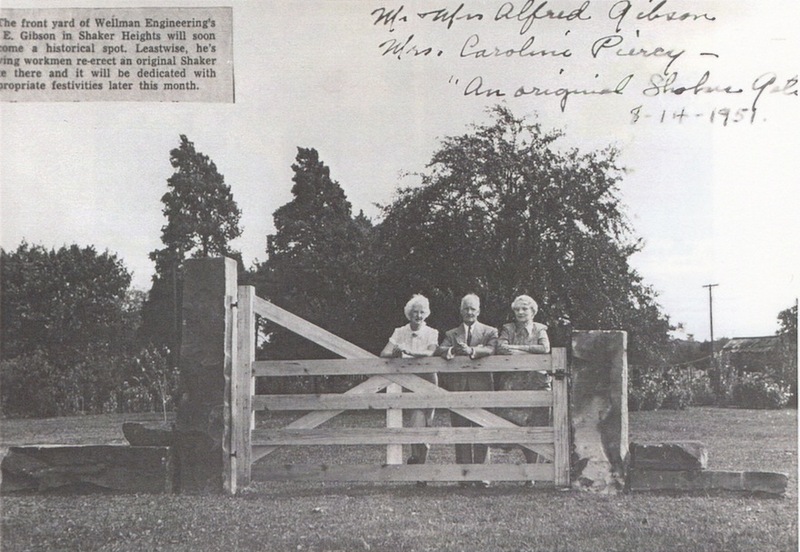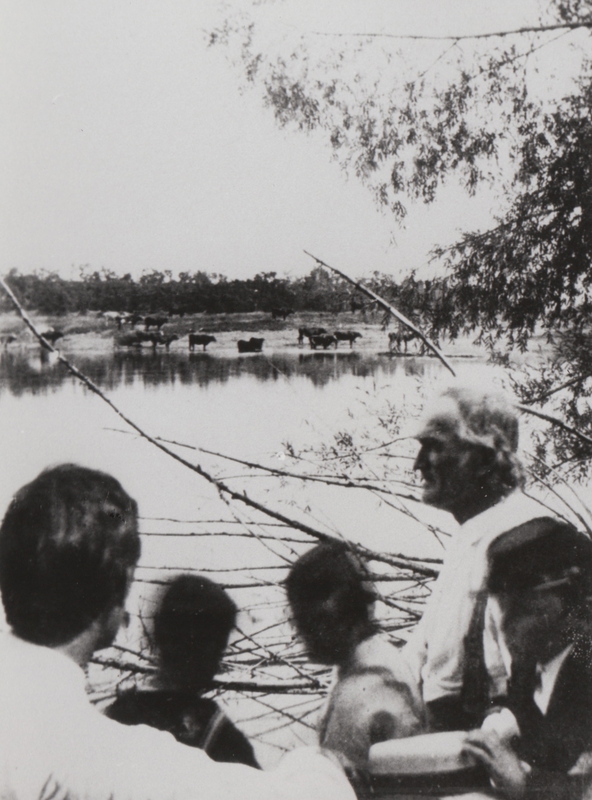
On September 21, 1948, the Shaker Historical Society commemorated its one-year anniversary with the unveiling of a bronze plaque on the southwest corner of Lee Road and Shaker Boulevard to mark the location of the Center Family of the North Union colony of Shakers. Five years later, a Shaker gate that had been added to the northeast corner was dedicated. The land adjoining this commemorative site, a 200-square-foot lot recently purchased by Shaker Historical Society, had previously been the location of the religious community's Meeting House, carpenter shop, blacksmith shop, dining room, and dormitories. A replica of the original gate that led onto the Shaker property was fashioned by members of the society, and large square cut stones that had once belonged to the Shakers were used as gate posts.
In retrospect, the Shakers seem an unlikely symbol of commemoration. The Cold War was in its infancy, and Shaker Heights was now one of America's wealthiest communities. A communal society had become an object of celebration in an era characterized by general disdain for all things that hinted of communism. Somehow, middle- and upper-class Shaker Heights residents came to identify with the values held by and projected upon this anti-materialist, apocalyptic religious society.
As the name Shaker Heights suggests, local interest in the Shaker community was partially rooted in the connection between the religious group and the history of the area. Development of the Shaker community coincided with early pioneer life in Warrensville, and spoke to the history of the region. The North Union Shaker colony was founded in 1822 and lasted until 1889. While segregated within their own communities, the lives of the Shakers were both influenced by and shaped the surrounding world. From the visits of Shaker men who consigned their garden seeds for local sale to the tale of a young Shaker women running off and marrying a local college student printed in the local paper, the lives of Shakers and Warrensville residents intersected. These interactions were most commonly a result of the commercial relationships that developed among Shakers and their neighbors. Although the religious order strived for self-sufficiency, the realities of providing for the needs of its members - reaching nearly 200 persons at the communities height - demanded the purchase and sale of goods. Products offered by the artisans, craftsmen, farmers, and millers were commonly acquired by Cleveland and Warrensville residents. While the contemporary accounts of encounters with North Union Shakers by the outside world regularly focused on the peculiarities of their social and religious customs, they were also portrayed as honest, hard working, and pious in nature. This reputation became intertwined in the popular perception of Shakers, and would remain even after the community had long since moved from the area. Tied to notions of peace, virtue, and rural life, the Shaker name would be memorialized in the region's development at the turn of the 20th century.
This fascination with Shaker life and culture was not unique to Shaker Heights. The reclusive Shaker religious community had always captured the imagination of the American public, and had increasingly been the subject of academic study since the 1920s. In addition, antique collectors had long been fixated with the many high quality products that were created for and sold by Shaker communities. Initially viewed as a fanatic religious group in both Europe and America, popular perception of the millenarian society had changed dramatically. Underlying this change was the relative extinction of the religious community, with its practitioners having been relegated to history and nostalgia. By mid-century, all but three Shaker communities in the New England area had closed their doors. The population of Shakers within these remaining colonies had greatly dwindled in numbers. To the outside world, the communities had became living museums – relics of a fascinating pioneer past.
The memory and perception of Shakers was defined greatly by both progressive interpretations of their faith and the material culture that was left behind. Shakers had long been known for their pacifist views, support of abolitionism, and the institution of gender and racial equality within their communities. Admiration for the egalitarian philosophy of the Shakers would find new resonance with historians and Shaker enthusiasts as both the civil rights and women's rights movement received increased popular support following World War II. Complementing the perception of Shakers being forward-thinking and pious, the physical artifacts left behind by the religious order spoke to a history of innovation and industriousness. The Shakers were renowned for their craftsmanship in woodwork and basket making. They had also received credit for many inventions, including the flat broom, circular saw, and revolving oven.
The commemoration of Shakers was a celebration of mainstream values. The values that the Shaker name had come to embody by the mid-twentieth century, however, were divorced from many of the teachings and beliefs of the religious community. Practices such as celibacy or removing oneself from the influence of material goods were generally dismissed as peculiar. Competing interpretations of Christianity, such as the belief in the second coming of Christ and the rejection of the Trinity, were similarly swept aside. Even though the social and religious beliefs of the Shakers diverged from mainstream thought, the near-extinct religious group offered little threat to the status quo. With attention focused on their many admirable qualities, the Shakers could be safely admired and commemorated. The society envisioned and created by Shaker communities during the 18th and 19th century had effectively been culled for representations of utopian idealism, a virtuous rural America, and pioneer ingenuity. The grounds were designated a Shaker Heights Landmark in 1976.
Images






